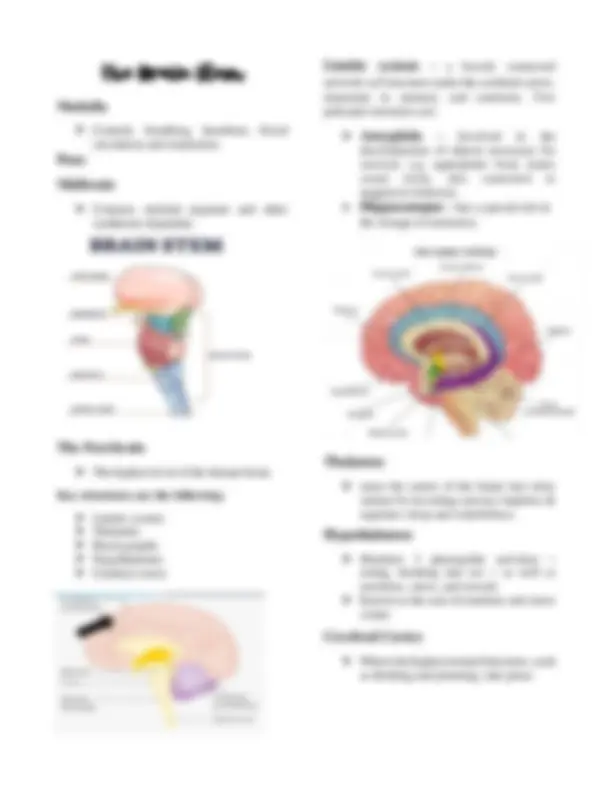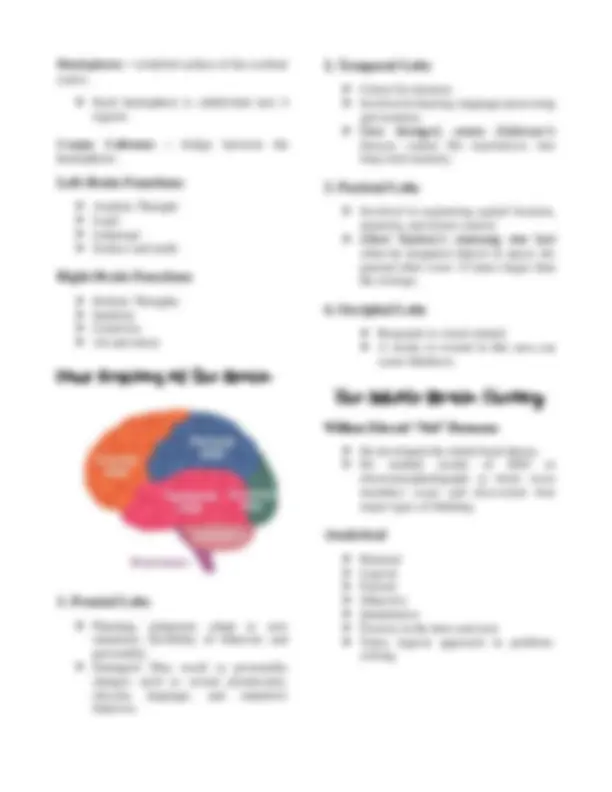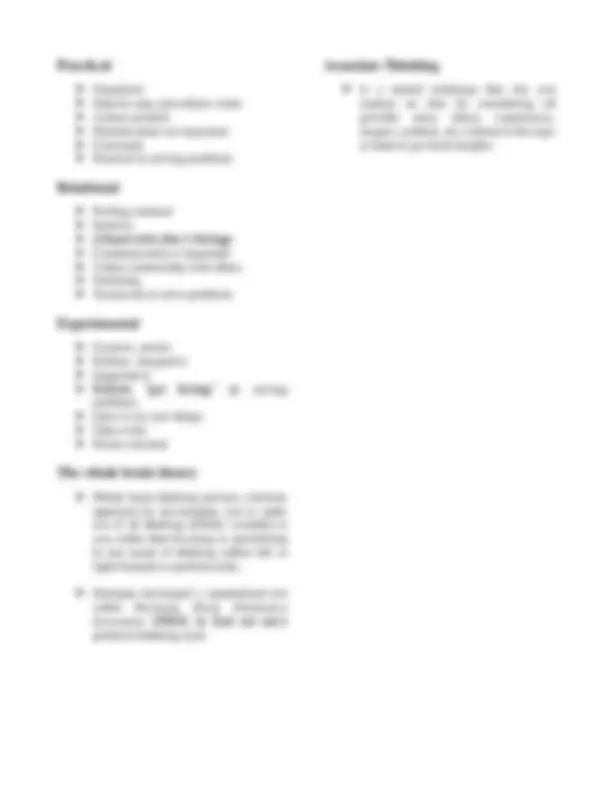





Study with the several resources on Docsity

Earn points by helping other students or get them with a premium plan


Prepare for your exams
Study with the several resources on Docsity

Earn points to download
Earn points by helping other students or get them with a premium plan
Community
Ask the community for help and clear up your study doubts
Discover the best universities in your country according to Docsity users
Free resources
Download our free guides on studying techniques, anxiety management strategies, and thesis advice from Docsity tutors
This lecture notes contains the following; • Neurobiological Psychology • Functions of Neurons • The Peripheral Nervous System • Central Nervous System • Four Region of the Brain • The Whole Brain Theory
Typology: Lecture notes
1 / 5

This page cannot be seen from the preview
Don't miss anything!




➢ A scientific field of behavioral neuroscience. ➢ Behavior is not only governed by psychosocial factors alone but also by biological process.
➢ The Neuron – Basic structural unit. ➢ Cell body (soma) – Nucleus is centrally located and is center of nourishment. ➢ Axon – Conducts nerve impulses away from the cell body (sender). ➢ Dendrite – Conducts neutral impulses towards the cell body (receiver).
➢ Sends impulses from the receptors to the brain.
➢ At the endings if each neuron are synaptic terminals; the gap between neurons is called synaptic gap. ➢ The junction where synaptic terminals meet is called synapses. ➢ Each synaptic terminal contains neurotransmitters. ➢ Chemical substances that carry messages across the synapse either to excite other neurons or to inhibit their firing.
➢ Facilitates learning and memory. ➢ Controls muscle contractions. ➢ Deficiency i. Disrupts learning and memory. ii. Alzheimer’s disease
➢ As a stress hormone, it affects part of the human brain where attention and responding actions are controlled. Along with epinephrine, norepinephrine underlies the fight-or-fight response, directly increasing heart rate, triggering the release of glucose from energy stores, and increasing skeletal muscle readiness. ➢ Too little may lead to depression. ➢ Too much may cause hyperactivity.
➢ Major group-involved in the control of large muscle movements and ability to perceive pleasure. ➢ Oversupply leads to schizophrenic reactions (delusions and hallucinations) ➢ Undersupply leads to Parkinson’s disease.
➢ Involved in mood, sleep, eating. ➢ Lack produces insomnia, eating disorders. ➢ Prevents dreaming in the waking state. ➢ Considered as the worry chemical in the brain.
➢ GABA for short. ➢ Decrease the activity of the neuron. ➢ May decrease levels of anxiety. ➢ Valium and other anti-anxiety drugs increase the inhibiting effects of GABA.
➢ Carries messages from the CNS to the skeletal muscles that control movements of the body (voluntary).
➢ Largely concerned with involuntary functions such as respiration, circulation, and digestion; plays a role in emotion. (headache, diarrhea, stomachache when anxious) Prolonged emotional arousal can adversely affect the true health of the organs controlled by the autonomic nervous system.
Two Subdivisions:
activation or arousal function, and it tends to act as mobilizes the body; sometimes called the fight-or-fight response
down body processes and maintains a state of tranquility. By working together, the 2 subdivisions can maintain homeostasis – a delicately balanced or constant internal state.
➢ Seat of consciousness and higher mental process. ➢ Protected by the bony structure called the cranium or skull. ➢ Largest part of the nervous system.
➢ Receiving center and point of departure for sense impulses. ➢ Protected by vertebral bone.
➢ The lowest portion of the brain where the spinal cord rises to meet the brain. ➢ Has 3 parts: medulla, cerebellum, and pons.
➢ Coordinates somatic motor activity. ➢ Regulates muscle tone and maintains equilibrium of the body. ➢ A.K.A. “Little Brain”
➢ Relays information between the eyes and the ears. 2 systems:
collection of neurons involved in the stereotyped patterns of behavior, e.g., walking, sleeping, turning to attend to a sudden noise.
basic survival functions. e.g., breathing heartbeat, blood pressure. Includes much of the hindbrain except for the cerebellum.
Hemispheres – wrinkled surface of the cerebral cortex. ➢ Each hemisphere is subdivided into 4 regions Corpus Callosum – bridge between the hemispheres Left-Brain Functions ➢ Analytic Thought ➢ Logic ➢ Language ➢ Science and math Right-Brain Functions ➢ Holistic Thoughts ➢ Intuition ➢ Creativity ➢ Art and music Four Regions of the Brain
1. Frontal Lobe ➢ Planning, judgment, adapt to new situations, flexibility of behavior and personality. ➢ Damaged: May result to personality changes such as sexual promiscuity, obscene language, and impulsive behavior. 2. Temporal Lobe ➢ Center for memory ➢ Involved in hearing, language processing and memory. ➢ Once damaged, causes Alzheimer’s disease; cannot file experiences into long-term memory. 3. Parietal Lobe ➢ Involved in registering spatial location, attention, and motor control. ➢ Albert Einstein’s reasoning was best when he imagined objects in space; his parietal lobes were 15 times larger than the average. 4. Occipital Lobe ➢ Responds to visual stimuli. ➢ A stroke or wound in this area can cause blindness. The Whole Brain Theory William Edward “Ned” Hermann ➢ He developed the whole brain theory. ➢ He studied results of EEG or electroencephalograph (a brain wave machine) scans and discovered four major types of thinking: Analytical ➢ Rational ➢ Logical ➢ Factual ➢ Objective ➢ Quantitative ➢ Focuses in the here-and-now ➢ Takes logical approach in problem- solving
Practical ➢ Organized ➢ Step-by-step, procedures count ➢ Action-oriented ➢ Detailed plans are important ➢ Consistent ➢ Practical in solving problems Relational ➢ Feeling-oriented ➢ Intuitive ➢ Attuned with other’s feelings ➢ Communication is important ➢ Values relationship with others ➢ Nurturing ➢ Teamwork to solve problems Experimental ➢ Creative, artistic ➢ Holistic, integrative ➢ Imaginative ➢ Follows “gut feeling” in solving problems ➢ Likes to try new things ➢ Takes risks ➢ Future-oriented The whole brain theory ➢ Whole brain thinking pursues a holistic approach by encouraging you to make use of all thinking abilities available to you, rather than focusing or specializing in one mode of thinking (either left or right brained) to perform tasks. ➢ Hermann developed a standardized test called Hermann Brain Dominance Instrument (HBDI) to find out one’s preferred thinking style. Associate Thinking ➢ Is a mental technique that lets you explore an idea by considering all possible areas (ideas, experiences, images, symbols, etc.) related to the topic at hand to get fresh insights.